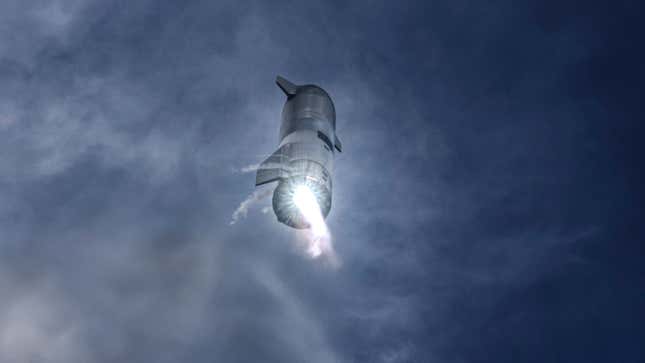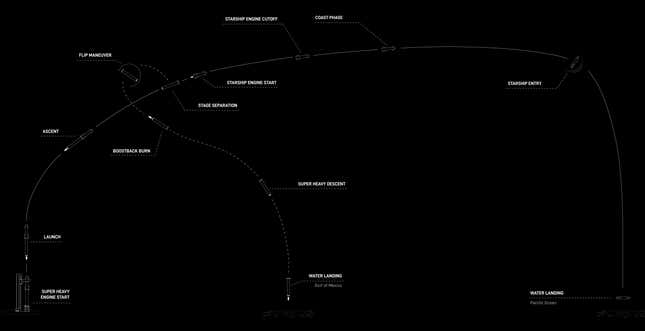The time is quickly nearing for SpaceX to perform the first fully integrated orbital flight test of Starship. Here’s how the historic launch will unfold and what you can expect from Elon Musk’s revolutionary megarocket.
The significance of this launch cannot be overstated given the importance of Starship to SpaceX, NASA, and the spaceflight industry as a whole. Standing 394 feet (120 meters) tall, Starship will instantly become the most powerful rocket to take flight the moment it clears the launch tower. SpaceX is currently targeting Monday, April 17 for launch, pending regulatory approval, good weather conditions, and favorable final checkouts of the rocket.
Advertisement
At liftoff, the rocket will exert about 16.5 million pounds of force, which is obviously impressive, but even more impressive is Starship’s pending status as a fully reusable launch vehicle. The fact that SpaceX wants to reuse both the Super Heavy booster and the Starship upper stage boggles the mind.
Related article: The Definitive Guide to SpaceX’s Starship Megarocket
That success will be achieved during the rocket’s first flight is hardly a certainty. Last month, SpaceX CEO Musk predicted a 50% chance of success for the inaugural mission. “I’m not saying it will get to orbit, but I am guaranteeing excitement,” Musk said during a Morgan Stanley Conference interview held on March 7.
Advertisement
Advertisement
SpaceX typically takes an iterative approach to product development and Starship is no exception. The company wrote on its Starship launch page: “With a test such as this, success is measured by how much we can learn, which will inform and improve the probability of success in the future as SpaceX rapidly advances development of Starship.” Indeed, you gotta start somewhere, even if that “somewhere” results in the total loss of the vehicle.

Advertisement
To be fair, this launch isn’t coming out of the blue. The Starship upper stage has performed successful high-altitude flights and managed to land safely on the surface during a final test done in May 2021. The Super Heavy booster has also undergone tests, including a full-scale static fire test on February 9, during which 31 of its 33 engines were engaged.
The stage is now set for the first orbital demonstration of the nearly 40 stories tall Starship megarocket. Assuming all goes well, here’s how it’ll all go down.
Advertisement
Commencing Starship countdown, Raptor engines on
The fully integrated Starship is currently mounted at the nearly 500-foot-tall (146 meters) launch and catch tower at SpaceX’s Starbase facility in Boca Chica, Texas. The specially constructed tower, with its two gigantic “chopstick” arms, is designed to “catch” the booster upon its return, but SpaceX won’t perform this daring stunt during the inaugural mission.
Advertisement
For this test, SpaceX is using a Super Heavy it calls Booster 7 and a Starship upper stage known as Ship 24. These two components were stacked together at the launch mount on April 5.
On the day of the launch, SpaceX’s flight director will run a poll and give the go-ahead for propellant load, setting the two-hour countdown clock into motion. The process of loading supercooled liquid oxygen and methane into the booster will happen some 20 minutes later, followed by the loading of the same propellants into the Starship upper stage. Chilling of the 33 Raptor 2 engines will commence once the countdown clock is down to less than 17 minutes. The Raptor startup sequence will begin with 8 seconds left to go, followed shortly thereafter by the much-anticipated liftoff.
Advertisement
Make Starship go now
With—hopefully—all 33 engines engaged and the rocket moving along its intended trajectory, the vehicle will travel along an easterly path above the Gulf of Mexico. Starship will reach MaxQ—the moment of maximum aerodynamic stress—at the 55-second mark of the mission. The booster’s boosting duties will end towards the three-minute mark of the mission, quickly followed by stage separation and ignition of the methane-fueled upper-stage engines in the vacuum of space.
Advertisement

As noted, the Super Heavy first stage won’t return to Boca Chica and will instead splash down in the Gulf of Mexico some eight minutes into the mission. That said, the booster will go through the motions of a controlled return and landing, including a flip maneuver, boost-back burn, and landing burn, the latter of which will see the rocket descend slowly before hitting the open ocean.
Advertisement
Traveling in space, the upper stage Starship could reach speeds nearing 5 miles per second (8 kilometers per second) before taking the plunge back down to Earth. The Starship upper stage won’t complete a full orbit of Earth and will instead perform a reentry some 77 minutes into the mission. Harvard-Smithsonian astronomer Jonathan McDowell refers to this chosen path as a “marginal-orbit trajectory.” People may grumble after this mission that Starship didn’t actually reach “orbit” because it didn’t settle in low Earth orbit and complete a full rotation of Earth, which is fair.
Advertisement
McDowell’s models have Starship traveling above the Caribbean, Atlantic Ocean, southern Africa, the Indian Ocean, northern Australia, Indonesia, and the Pacific Ocean. Starship is expected to reenter the atmosphere over the Pacific and perform a splash down around 62 miles (100 km) northwest of Kauai, Hawaii. That should happen at the 90-minute mark, effectively ending the inaugural mission.
Should it get that far, the rocket could conceivably fail at any point during the mission, or exhibit undesirable behaviors, such as some engines not firing or unacceptable wear-and-tear during the reentries. First flights seldom succeed in the rocket industry, but the incoming data will prove invaluable to SpaceX; the company will scrutinize data relating to the rocket, its engines, computers, and ground systems. These findings will, in turn, inform the second Starship mission, which, depending on how things go next week, could happen later this year.
Advertisement
Starship will very likely become a bona fide rocket someday, but as SpaceX has proven before, these things don’t happen overnight.
Want to know more about Elon Musk’s space venture? Check out our full coverage of SpaceX’s Starship megarocket and the SpaceX Starlink internet satellite megaconstellation. And for more spaceflight in your life, follow us on Twitter and bookmark Gizmodo’s dedicated Spaceflight page.
Services Marketplace – Listings, Bookings & Reviews